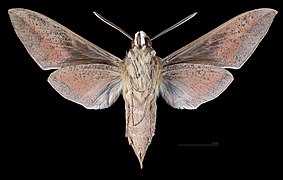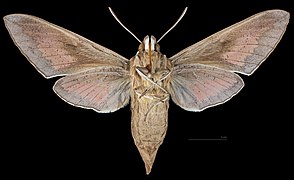Species of moth
| Seathorn hawk-moth
|

|
|
|
|
|
Scientific classification 
|
| Domain:
|
Eukaryota
|
| Kingdom:
|
Animalia
|
| Phylum:
|
Arthropoda
|
| Class:
|
Insecta
|
| Order:
|
Lepidoptera
|
| Family:
|
Sphingidae
|
| Genus:
|
Hyles
|
| Species:
|
H. hippophaes
|
| Binomial name
|
Hyles hippophaes
|
| Synonyms
|
- Sphinx hippophaes Esper, 1789
- Deilephila insidiosa Erschoff, 1874
- Celerio hippophaes teriolensis Dannehl, 1929
- Celerio hippophaes obscurata Dannehl, 1929
- Celerio hippophaes kiortsii Koutsaftikis, 1974
- Celerio hippophaes flava Denso, 1913
- Celerio hippophaes expallidata Dannehl, 1933
- Celerio hippophaes crocea Rebel, 1910
- Deilephila hippophaes bienerti Staudinger, 1874
- Celerio hippophaes shugnana Sheljuzhko, 1933
- Celerio hippophaes ornatus Gehlen, 1930
- Celerio hippophaes malatiatus Gehlen, 1934
- Celerio hippophaes caucasica Clark, 1922
- Celerio hippophaes bucharana Sheljuzhko, 1933
- Celerio hippophaes baltistana O. Bang-Haas, 1939
- Celerio hippophaes anatolica Rebel, 1933
- Hyles hippophaes transcaucasica Gehlen, 1932
- Hyles hippophaes caucasica Denso, 1913
|
Hyles hippophaes, the seathorn hawk-moth, is a species of moth in the family Sphingidae. The species was first described by Eugenius Johann Christoph Esper in 1789.
Distribution
It is found in Afghanistan, Armenia, Azerbaijan, China, France, Georgia, Germany, Greece, Iran, Iraq, Kazakhstan, Kyrgyzstan, Mongolia, Pakistan, Romania, Serbia and Montenegro, Spain, Switzerland, Syria, Tajikistan, Turkey, Turkmenistan, and Uzbekistan.
Description
The wingspan is 65–80 mm. Subspecies H. h. bienerti is paler and browner than related subspecies. A pale, oblique median line is noticeable on the underside of the forewing. The hindwing patches are more orange than red.
-
Hyles hippophaes ♂
-
Hyles hippophaes ♂ △
-
Hyles hippophaes ♀
-
Hyles hippophaes ♀ △
Biology
Larvae of subspecies H. h. bienerti have been recorded on Elaeagnus angustifolia and Hippophae rhamnoides in China and Tajikistan.





